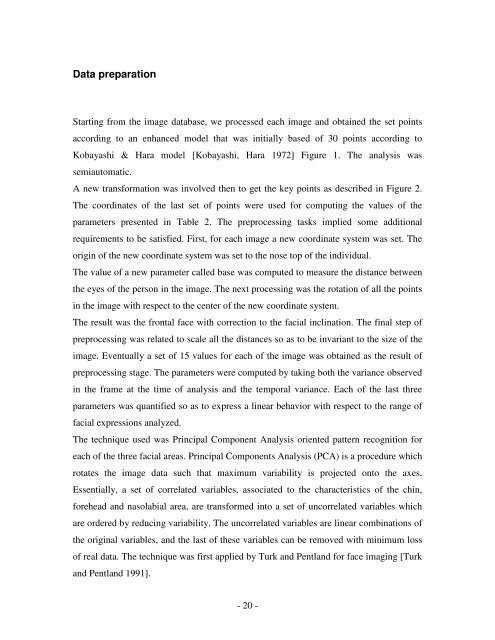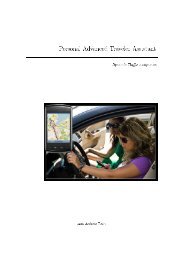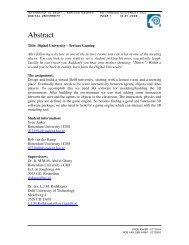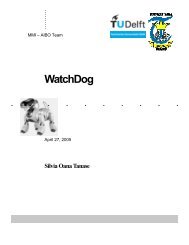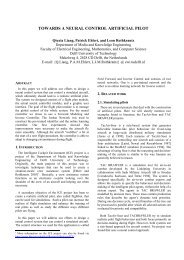Recognition of facial expressions - Knowledge Based Systems ...
Recognition of facial expressions - Knowledge Based Systems ...
Recognition of facial expressions - Knowledge Based Systems ...
You also want an ePaper? Increase the reach of your titles
YUMPU automatically turns print PDFs into web optimized ePapers that Google loves.
Data preparation<br />
Starting from the image database, we processed each image and obtained the set points<br />
according to an enhanced model that was initially based <strong>of</strong> 30 points according to<br />
Kobayashi & Hara model [Kobayashi, Hara 1972] Figure 1. The analysis was<br />
semiautomatic.<br />
A new transformation was involved then to get the key points as described in Figure 2.<br />
The coordinates <strong>of</strong> the last set <strong>of</strong> points were used for computing the values <strong>of</strong> the<br />
parameters presented in Table 2. The preprocessing tasks implied some additional<br />
requirements to be satisfied. First, for each image a new coordinate system was set. The<br />
origin <strong>of</strong> the new coordinate system was set to the nose top <strong>of</strong> the individual.<br />
The value <strong>of</strong> a new parameter called base was computed to measure the distance between<br />
the eyes <strong>of</strong> the person in the image. The next processing was the rotation <strong>of</strong> all the points<br />
in the image with respect to the center <strong>of</strong> the new coordinate system.<br />
The result was the frontal face with correction to the <strong>facial</strong> inclination. The final step <strong>of</strong><br />
preprocessing was related to scale all the distances so as to be invariant to the size <strong>of</strong> the<br />
image. Eventually a set <strong>of</strong> 15 values for each <strong>of</strong> the image was obtained as the result <strong>of</strong><br />
preprocessing stage. The parameters were computed by taking both the variance observed<br />
in the frame at the time <strong>of</strong> analysis and the temporal variance. Each <strong>of</strong> the last three<br />
parameters was quantified so as to express a linear behavior with respect to the range <strong>of</strong><br />
<strong>facial</strong> <strong>expressions</strong> analyzed.<br />
The technique used was Principal Component Analysis oriented pattern recognition for<br />
each <strong>of</strong> the three <strong>facial</strong> areas. Principal Components Analysis (PCA) is a procedure which<br />
rotates the image data such that maximum variability is projected onto the axes.<br />
Essentially, a set <strong>of</strong> correlated variables, associated to the characteristics <strong>of</strong> the chin,<br />
forehead and nasolabial area, are transformed into a set <strong>of</strong> uncorrelated variables which<br />
are ordered by reducing variability. The uncorrelated variables are linear combinations <strong>of</strong><br />
the original variables, and the last <strong>of</strong> these variables can be removed with minimum loss<br />
<strong>of</strong> real data. The technique was first applied by Turk and Pentland for face imaging [Turk<br />
and Pentland 1991].<br />
- 20 -


